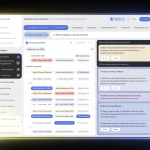
Understanding Customer Data in Retail
Customer data is a critical asset in the retail industry, enabling businesses to understand and cater to their customers more effectively.
This report delves into the types of customer data, the importance of customer segmentation, and how these elements contribute to a successful retail strategy.
Types of Customer Data
Customer data can be broadly categorized into three types: behavioral, transactional, and demographic. Each type provides unique insights that help retailers tailor their strategies to meet customer needs and preferences.
1. Behavioral Data
Behavioral data captures information about how customers interact with a brand across various channels. This type of data includes:
- Website Analytics: Page views, session duration, bounce rate, and click-through rates.
- Purchase History: Items viewed, added to cart, and purchased.
- Engagement Data: Email open rates, social media interactions, and customer service interactions.
- Browsing Patterns: Frequency of visits, time spent on different sections, and navigation paths.
Behavioral data helps retailers understand customer preferences, identify trends, and predict future behavior.
By analyzing this data, businesses can personalize the shopping experience and improve customer satisfaction.
2. Transactional Data
Transactional data records the financial interactions between customers and the retailer. This includes:
- Purchase Records: Details of each transaction, including products purchased, quantities, prices, and payment methods.
- Order History: Frequency of purchases, average order value, and lifetime value.
- Returns and Exchanges: Information on returned items, reasons for returns, and refund methods.
Transactional data provides insights into customer buying patterns, revenue generation, and product performance.
It helps retailers optimize inventory management, pricing strategies, and promotional activities.
3. Demographic Data
Demographic data encompasses information about customers’ characteristics and attributes. This includes:
- Personal Information: Age, gender, marital status, and family size.
- Geographic Data: Location, including city, state, and postal code.
- Socioeconomic Status: Income level, education, occupation, and household size.
Demographic data helps retailers segment their customer base and tailor marketing efforts to specific groups.
It also aids in understanding market potential and identifying target audiences for new products or services.
Importance of Customer Segmentation in Retail
Customer segmentation is the process of dividing a customer base into distinct groups based on shared characteristics.
Effective segmentation enables retailers to deliver more personalized and relevant experiences, enhancing customer satisfaction and loyalty.
Here’s why customer segmentation is crucial in the retail context:
1. Enhanced Personalization
Segmentation allows retailers to tailor marketing messages, product recommendations, and promotional offers to specific customer groups.
For example, a segment of young professionals might receive marketing for trendy, high-tech gadgets, while a segment of retirees might be targeted with comfortable, easy-to-use home appliances.
Personalized experiences make customers feel valued and understood, driving higher engagement and sales.
2. Improved Customer Retention
Understanding the needs and preferences of different customer segments helps retailers develop strategies to keep customers engaged and satisfied.
By addressing the specific pain points and desires of each segment, retailers can build stronger relationships and encourage repeat purchases.
For instance, offering exclusive loyalty programs or special discounts to high-value customers can significantly boost retention rates.
3. Better Resource Allocation
Segmentation enables retailers to allocate resources more efficiently.
By identifying high-value segments, retailers can focus their marketing efforts and budget on the most profitable groups.
This targeted approach maximizes return on investment (ROI) and ensures that marketing dollars are spent where they are most likely to generate results.
4. Effective Product Development
Customer segmentation provides valuable insights into market needs and trends.
Retailers can use this information to develop new products or modify existing ones to meet the specific demands of different segments.
For instance, a retailer might introduce a new line of eco-friendly products after identifying a growing segment of environmentally conscious consumers.
5. Competitive Advantage
Retailers that effectively segment their customer base and deliver personalized experiences can differentiate themselves from competitors.
A deep understanding of customer segments allows retailers to offer unique value propositions and stay ahead of market trends.
This competitive edge can attract new customers and foster brand loyalty.
Implementing Customer Segmentation
To implement effective customer segmentation, retailers should follow a systematic approach:
Data Collection:
Gather comprehensive data from various sources, including online and offline interactions, purchase history, and customer feedback.
Ensure data accuracy and completeness.
Data Analysis:
Use analytical tools and techniques to identify patterns and correlations in the data. Group customers based on shared characteristics and behaviors.
Segmentation Criteria:
Define the criteria for segmentation based on the business objectives and available data.
Common criteria include demographic attributes, purchase behavior, and engagement levels.
Profile Creation:
Develop detailed profiles for each segment, outlining key characteristics, preferences, and needs.
These profiles serve as a reference for personalized marketing and customer engagement strategies.
Targeted Strategies:
Design and implement targeted marketing campaigns, product offerings, and customer service initiatives for each segment.
Monitor the performance and adjust strategies based on feedback and results.
Continuous Improvement:
Regularly review and refine segmentation criteria and strategies to adapt to changing customer behaviors and market conditions.
Continuously seek ways to enhance the customer experience for each segment.
Understanding customer data and effectively segmenting the customer base are vital components of a successful retail strategy.
Behavioral, transactional, and demographic data provide a comprehensive view of customers, enabling retailers to deliver personalized experiences, improve retention, allocate resources efficiently, and gain a competitive advantage.
By implementing a structured approach to customer segmentation, retailers can better meet the diverse needs of their customers and drive business growth in a dynamic market landscape.
Retailers that invest in understanding and leveraging customer data will be well-positioned to thrive in an increasingly competitive and customer-centric industry.


